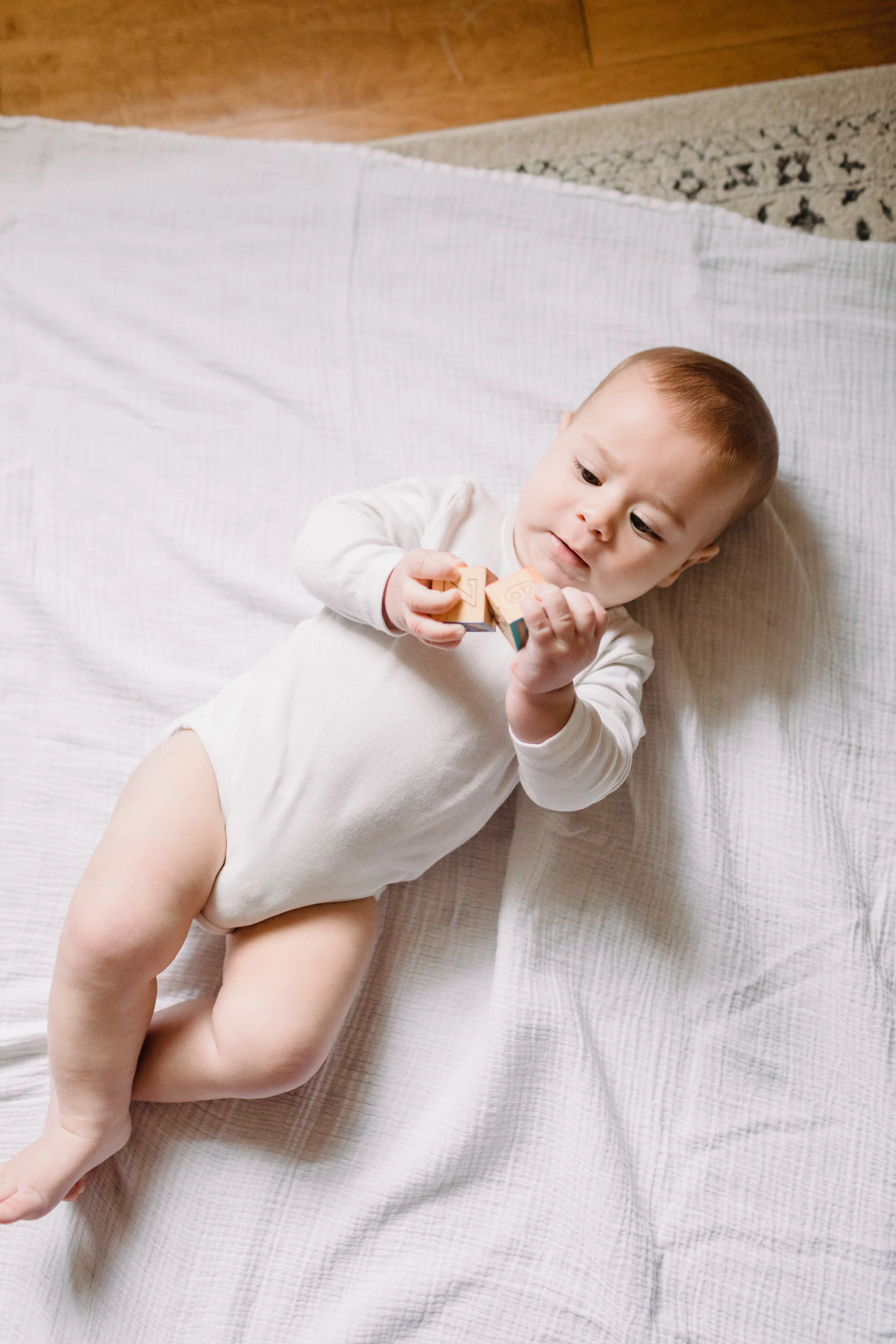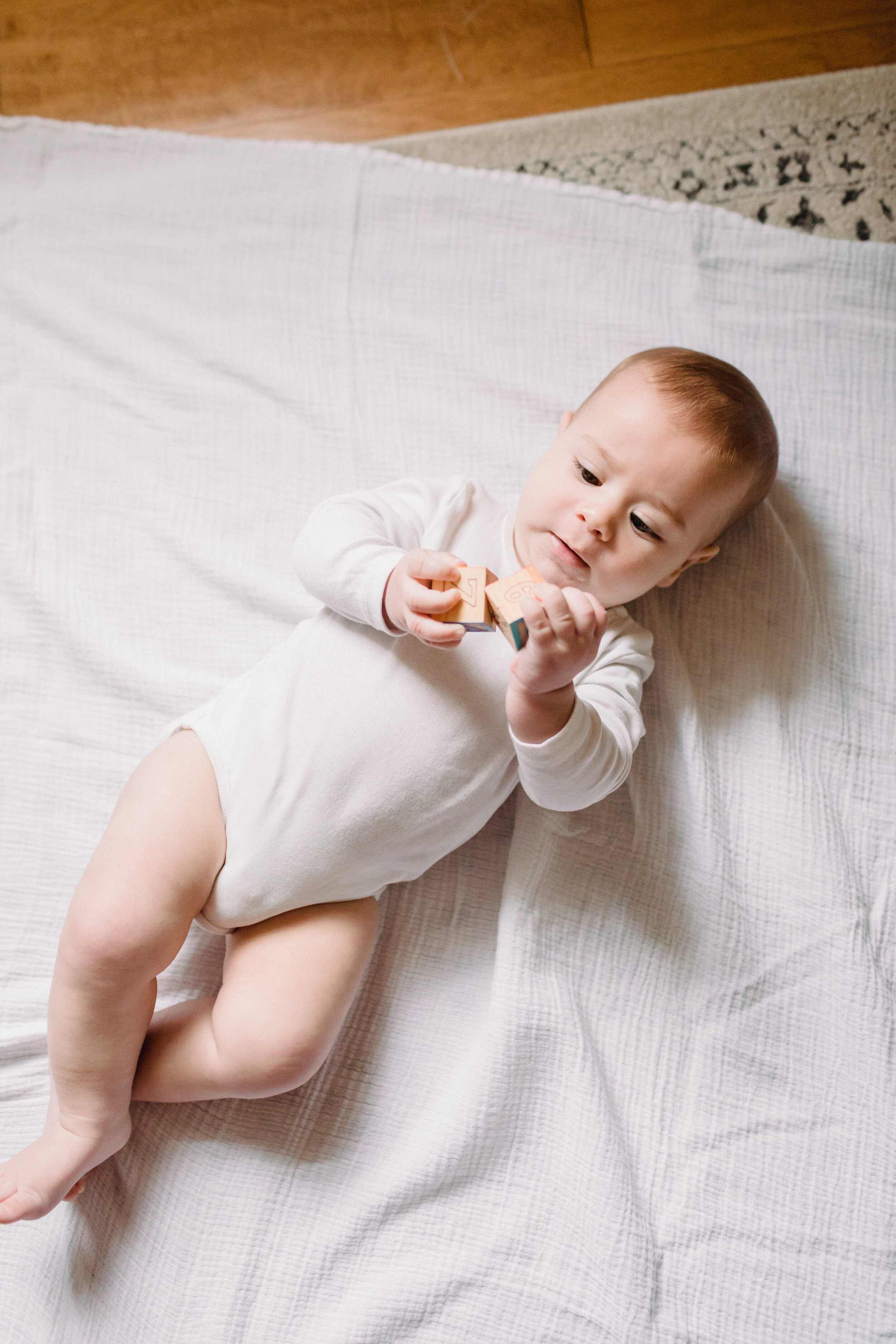This blog looks at hand development and the long term impact it has on babies over the course of their life. Here, we cover the first 12 months. If you’re looking for play ideas click here, for quick tips - check out and share our Instagram.
Hand Development
Babies begin with fisted hands that quickly learn to open and explore through experiences of touching objects and textures. Babies first open their hands and bat at objects or hit them in a sort of uncoordinated way. That leads to grabbing toys, holding and exploring them, and then voluntarily releasing them (~9 months). Baby then picks up stick shaped items and starts to develop better wrist skills as they turn and explore toys, bring hands together and bang toys. This new dexterity leads to self-feeding, dipping, scooping, and bringing items to their mouth successfully.
How hand skills progress through play:
0-2 months - Mostly closed/fisted hands, begins to hold an object placed in the hand ~6 weeks
2-4 months - Hands begin to open, thumb tucked into palm less often, begin to bat at (hit) toys and hold toys at midline (center of body), brings hands to mouth, starts to push up through extended arms in tummy time
4-6 months - Transfers toy between hands, uses a raking (whole handed) grasp, begins to develop an open webspace (the ability to hold a toy between thumb and finger tips without it touching the palm)
6-9 months - Consistently releases toys, claps, bangs toys together, holds spoon with a cylindrical grasp (fisted around spoon handle), holds a cup with handles
9-12 months - Points, uses pincer grasp (tip of pointer and thumb) to pick up small items, turns pages in book
Info on specific play activities here!
Hands and Feeding
With practice, baby’s hand and wrist skills get better. Around 9-12 months, they begin to scoop instead of just dip and the spoon into purees. Baby also has to practice getting the spoon to their mouth without dumping it all over themselves - this is another hand, eye, and wrist progression. We love these NumNum Gootensils because they perfectly pair with babies’ hand development. They’re perfect for using a cylindrical grasp and dipping into a puree. These Gootensils help keep the puree on the spoon so when it gets to baby’s mouth, there is still food there; that is how baby is reinforced and learns to do the motor pattern again and again. Baby refines the process through trial and error learning.
(Not sponsored, we just truly love these!)
Hand Development and Dexterity
If you watch a baby’s hand and wrist muscles carefully while they’re crawling, you’ll notice that baby is always making slight adjustments, like your foot and ankle do when you balance on one foot. Those slight movements in the hands and wrist are refining the 34 muscles that move the fingers and thumb. Tummy time and crawling provide exceptional opportunities for baby to refine these tiny muscles and develop the arches in the palms of the hands. These arches and refined muscles will later allow the child to accurately shape their hand to reach for and grab a cup, hold a fork, write their name, tie shoes, throw a ball, type. The list of activities people do with refined hand movements and good dexterity goes on and on. Read more here for more detailed info on hand development and crawling.
Hand skills and Language:
Studies have found that both fine motor (hand and eye skills) and gross motor skills (bigger muscle movements) “help foster language development from infancy to early childhood.” (Gonzalez, S. et. al., 2019). Studies found that when babies engaged in fine motor play with parents, they had higher receptive (understanding) language skills. Houwen et al. (2016). This is likely due to the repetitive language modeling of naming the object over and over in play or pointing to and labeling pictures in books. For more info on simple play to promote language check our post here.
Hand skills develop and evolve through experience throughout the first year. Try to give your baby lots of opportunities to pick up, feel, mouth, and explore toys. Engage in turn taking, model how to use toys, point to, rotate, and talk about the toys while you play together. Hand skills lay down a foundation for interacting with the world in many ways.
Stay tuned for more info on toddler hand skills - coming soon!
-Bree
We’re Jaclyn & Bree
Pediatric therapists and moms with a mission to empower you with knowledge to encourage your baby’s development and continue confidently into your parenthood journey.
If you have any questions, please feel free to leave a comment below and we will get back to you. As always, the information we share is meant to provide general education and tips and is not intended as medical advice. If you have a specific question or concern about your child’s development, please speak directly to your child’s doctor or therapist.
References:
Gonzalez, S. L., Alvarez, V., & Nelson, E. L. (2019). Do Gross and Fine Motor Skills Differentially Contribute to Language Outcomes? A Systematic Review. Frontiers in psychology, 10, 2670. https://doi.org/10.3389/fpsyg.2019.02670
Houwen S., Visser L., van der Putten A., Vlaskamp C. (2016). The interrelationships between motor, cognitive, and language development in children with and without intellectual and developmental disabilities. Res. Dev. Disabil. 53, 19–31. 10.1016/j.ridd.2016.01.012 [PubMed]






